
|
* A RARE .177 SMOOTHBORE BREAK-BARREL GALLERY AIR-PISTOL SIGNED 'MAURITZ WIDFORSS', MODEL 'GEM TYPE', no visible serial number, almost certainly the product of Oskar Will, Germany circa 1900, with blued round 10 1/2in. barrel with 'gem' type breech-block, the latter signed on the left hand side 'TILLVERKADT 1. THURINGEN F ? MAURITZ WIDFORSS H A B STOCKHOLM' (one word obscured), dove-tailed blade fore-sight, standing notch rear-sight forwards of the nickel-plated 'T' bar locking latch, plain large diameter nickel-plated air-chamber (losses to plating), square-fronted trigger-unit with long top-tang, chequered walnut bag-shaped butt, nickel-plated trigger-guard with finger spur, long adjustment screw behind trigger-blade and straight nickel-plated cocking bar
Please note VAT at 5% is applicable on the hammer price.
£300-500
|
|
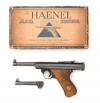
|
** HAENEL, GERMANY
A BOXED .177 & .22 CYLINDER-COCKING AIR-PISTOL, MODEL '28', no visible serial number, circa 1930, with interchangeable hinged 4in. rifled barrels fitted with blade fore-sights, adjustable buckhorn style rear-sight, hinged air-chamber lifting to cock, the top of chamber stamped 'HAENEL AIR PISTOL, BRIT. PAT. NO. 277265', coin-edged cylinder end-cap, push-button cylinder release forwards of the trigger-guard bow and smooth wood grips, retaining most of its original blued finish; COMPLETE WITH its manufacturer's card carton with buff printed label to lid, the inside with instruction label, the tray with card compartments for the spare barrel and a boxed sample of pellets (currently containing the spare barrel hinge screw), the carton scuffed and worn at edges
Please note VAT at 20% is applicable on the hammer price.
£150-250
|
|
| |
* BSA
A .22 UNDER-LEVER AIR-RIFLE, MODEL 'IMPROVED MODEL 'D' TARGET', serial no. 51484, for 1912, 45in. overall, with blued 19in barrel, dove-tailed beaded-blade fore-sight, rear-sight dove-tail blanked off with a plate, marked '2' in front of the load-tap, plain air-chamber marked 'THE BSA AIR RIFLE (IMPROVED MODELD) , THE BIRMINGHAM SMALL ARMS CO LTD ENGLAND, SOLE MANUFACTURERS', one hole trigger-unit, walnut butt-stock with saw-handled chequered grip, the top inlet with a folding factory fitted peep-sight, no trademark stamped to butt, iron heel-plate and side-catch release under-lever stamped with BSA patents, traces of original finish under surface corrosion
Please note VAT at 5% is applicable on the hammer price.
£150-250
|
|
| |
* POPE BROS., USA
A SCARCE CASED .210 BARREL-COCKING AIR-PISTOL, serial no. 4690, COMPLETE WITH WIRE SHOULDER-STOCK, circa 1876, with nickel-plated pull-out 11in. barrel, pillar fore-sight, standing notch rear-sight on the barrel support, blued cocking linkage piece, cast nickel-plated air-chamber with integral semi-birdshead grip, the end-cap marked 'POPE BROS. USA' in the centre and various international patents around the circumference, much original nickel-plating remaining; TOGETHER WITH its original rounded corner walnut storage case, the interior lined and compartmented in blue velvet containing the pistol along with its wire shoulder-stock and cleaning rod, two compartments for pellets and darts and two elastic loops (perished)
Please note VAT at 5% is applicable on the hammer price.
£200-300
GERNERAL SIR MILES DEMPSEYGenneral Sir Miles Christopher Dempsey, G.B.E., K.C.B., D.S.O., M.C. - An Historically Important Collection of Written Ephemera. General Sir Miles Dempsey was, unarguably, one of the very finest senior Allied officers of the Second World War. His abilities were manifold and he was directly responsible for the success of several notable battles, and yet due to his restraint and modesty his name is not often to the fore in discussion. In addition, Dempsey did not commit his memoirs to paper unlike many of his fellow Generals. The following Lots show not only just how well thought of the man was by the senior staff but, far more importantly, will place a question mark beside the now accepted events in connection to the Battle for Caen and the subsequent allied advance to the Rhine.All Lots are being offered at auction by the family, having been passed by descent to the vendor.Miles Dempsey's older brother was the Clan Chief of the ancient O'Dempsey Sept and his ancestor Terence O'Dempsey was Knighted on the battlefield in Ireland by the Earl of Leicester in 1599 and later ennobled by King Charles I as Viscount Clanmaliera and Baron Philipstown.Dempsey, known to his friends and close fellow officers as 'Bimbo' or 'Lucky', and latterly to his men as 'Two Hundred Miles' (following a period of rapid advance through Belgium), was born 15th December 1896 in the small resort of New Brighton in Cheshire. He was schooled at Shrewsbury before going to Sandhurst where he gained his commission in 1915 in the Royal Berkshire Regiment. He led his first command to France and the Western Front. Here he showed the first operational evidence of a mind possessed of great memory, an unsurpassed ability to interpret maps and not a little élan. In March 1918, he was gassed and subsequently had to have a lung removed. His efforts were formerly recognised in June 1919 when he was awarded the Military Cross for bravery.His military career advanced rapidly by peacetime standards in the inter-war years. Sensing that a further war was likely with Germany he spent many inter war holidays touring France and the Low Countries by bicycle to familiarise himself with the geography of what he felt sure would be future battlegrounds. By the time war broke out in 1939 he was already a Lieutenant Colonel, and C.O. of the 1st Battalion, Royal Berkshire Regiment. By the November of that year he was promoted to command the 13th Infantry Brigade which formed a part of the ill-fated British Expeditionary Force in France. The B.E.F.'s splendid evacuation from Dunkirk needs no expansion here except to note that as the Germans advanced swiftly and encircled the retreating allies, Dempsey's unit fought a fierce rear-guard action that bought precious time for the men at the beach-head. He was awarded the D.S.O. for his part in the evacuation.Described as a 'career infantryman', Dempsey then went on to command the 42nd Armoured Division. This was formed from various infantry units which were then equipped, as the title suggests, in an armoured role. He then transferred in the December of 1942, to take-over command from Lt.-Gen. Horrocks of the illustrious XIII Corps, formerly known as the Western Desert Force and part of the British 8th Army in North Africa. Montgomery's push west with the 8th Army struck a decisive blow and, together with the Allied Torch landings and subsequent advance eastwards, effectively pushed the Germans out of the southern Mediterranean. With the campaign in North Africa drawing to a close, Alexander appointed Dempsey in a key planning role for the invasion of Sicily before he once more took command of XIII Corps for the actual invasion, which at the time was the largest such undertaking in history. The experience Dempsey gained in the use of combined operations was to stand him in great stead when he led the British 2nd Army at D-Day. It was at this time that he first encountered the Special Raiding Squadron – forerunners of the S.A.S. His role in saving the S.A.S. as an independent force was later recognised in Dempsey becoming the regiment's first Colonel Commandant.The taking of Sicily represented a major turning point in the war; for the first time the Axis powers were being driven back in Europe, important sea lanes were opened for the first time since 1941 and the operation's success led the way to Mussolini being toppled from power. Operation Husky began on the night of 10th July 1943, and Dempsey led the British, Indian and Canadian assault on the southern beaches. The campaign officially ended 17th August with the allies now looking directly across the Strait of Messina at their next challenge.Less than a month later, Montgomery and Dempsey led the 8th Army across the Strait and stormed the beaches at Calabria and Taranto before sweeping north to link-up with the American 5th Army at Salerno. The Italian Campaign took a great toll on both sides and the allies met with fierce resistance from both the Italians and Germans. The former rather surprisingly as the coup that had deposed Mussolini initially sought to broker a peace. This, however, was the end of Dempsey's sojourn in southern Europe as a signal from Montgomery brought him back to England to take command of the huge 2nd Army. This, of course, was in preparation for Operation Overlord, the establishment of an allied lodgement in France, and both Montgomery and Eisenhower knew that Dempsey should be instrumental in the planning and execution of it.Operation Neptune, D-Day, was delayed by 24 hours due to weather and sea conditions but on 6th June 1944 the allies landed 160,000 men along the northern Normandy beaches (by the end of August that figure had risen to over 3,000,000). Dempsey's initial objective was to capture the medieval city of Caen, a strategic hub much-prized by the Germans. History has recorded that the British and Canadian's advance stalled at Caen causing some impatience amongst the American senior staff as their forces broke out of Bocage country heading south and east. Montgomery especially was subject to some rather harsh, and largely unwarranted criticism. However, a perfectly laudable alternative is under-pinned by some of the items offered for sale. The allies knew that Caen was heavily defended by some of Hitler's best units, including several SS-Panzer Divisions (some of which were on rest after being transferred from the east). By attacking the city, not only would these units be pinned-down but it would also draw in the infantry and light armoured units on the west side of the peninsula, thus allowing the Americans to break-out. The top brass at S.H.A.E.F. knew the 2nd Army would be held back for a time, but they also knew that Caen must be taken. It was already a transport hub, with roads and waterways, but the flat land surrounding much of it was ideal for landing grounds. Milton Shulman, a Canadian Intelligence Officer, wrote of Dempsey's plan of battle, "What better justification for the strategy adopted by allied planners to attract to the anvil of Caen the bulk of German armour, and there methodically hammer it to bits!" The irony in finally capturing what had been the ancient capital of the Norman Empire was not lost on Dempsey for in 1173, his ancestor Dermod O'Dempsey had notably defeated the famous Norman General Strongbow in Offaly, an engagement that kept the invaders out of Dempsey lands for three hundred years.With Caen finally taken by mid-August the 2nd Army swept south-east towards the Falaise Gap with the rapidly advancing American 1st Army to their south. The battered German Army Group B was effectively enveloped in the Falaise - Chambois pocket after Hitler had ordered a counter-offensive rather than a tactical withdrawal. The Germans fought tenaciously but their losses were huge, and what little remained of the group began to retreat east of the Seine. This allowed the Allies almost clear access to France's border with Germany, and with the liberation of Paris Operation Overlord was complete. Always a modest man, Dempsey had driven many allied efforts without ever taking the limelight. His efforts had not gone unrecognised though. King George VI paid a visit to the 2nd Army in October and on the 15th asked for a sword, and dubbed Dempsey as a Knight in the Most Honourable Order of the Bath. This was an honour indeed; the last time a reigning Monarch had knighted someone on the field of battle was at Agincourt in 1415. Thus for the second time in over three hundred years a Dempsey had been awarded a Knighthood on the actual field of battle.With France liberated and the Vichy administration put down, the allies turned their eyes north-east to the Rhine and Germany's sea ports. By the December of 1944 the allied line had reached the Ardennes region of Belgium when a major counter-offensive was launched against them. The attack was a complete surprise and a large salient was formed in the allied line, with the Americans taking the brunt of the fighting. It was a bitterly cold winter with the Armies under General Bradley's command operating under extreme and testing conditions. Counter attacks and offensives followed by both sides and it was fast developing into a situation of attrition. With failed communications between Bradley and the American 1st and 9th Armies (who had also lost contact with the entire U.S. command structure), Eisenhower placed Montgomery in command. In turn the leadership fell to Dempsey who temporarily took command over General Courtney Hodges' 1st Army and General William Simpson's 9th Army. Montgomery, though a great man, could be both caustic and arrogant, and was not well-received by many of the American Generals, but Dempsey got along very well with most of them (Simpson and Ridgeway especially) and the alliance proved effective in grinding down the German advance, which was ended by mid-January 1945. The battle exacted a heavy toll on both Americans and Germans but victory paved the way for an assault on the River Rhine.Operation Plunder began at night on 23rd March with four thousand allied guns opening fire on Wesel and the surrounding area accompanied by R.A.F. Bomber Command with an aerial bombardment, all watched by Churchill who was at Montgomery's Tactical HQ. Dempsey led the 2nd Army and U.S. 9th Army and the Rhine was crossed at Rees with a bridge-head being formed against a possible counter-attack by General Schlemm's 1st Parachute Army. The operation was a complete success and Dempsey was the first senior British officer to cross the river on a quickly erected Bailey bridge. By now German resistance, though courageous, was crumbling and Dempsey advanced quickly taking the strategically important ports of Bremen, Hamburg and Kiel (ending safe haven for the U-Boats).On 3rd May at 1100 a delegation of senior German officers arrived at Dempsey's Tac HQ led by Gen. Admiral von Friedeberg. It soon emerged that they were representing General Keitel and Admiral Donitz (themselves representing Army and Naval forces) who wished to surrender. It is recorded that true to form, Dempsey dismissed them with instructions to report to his superior officer. So it was that next day the Germans formerly surrendered in North West Europe to Montgomery at Lüneberg Heath.Total surrender, and the end of hostilities in Europe, took place on 8th May and Dempsey bade farewell to his beloved 2nd Army in August. From here he moved to command the British 14th Army as G.O.C-in- C. Malaya Command, and from there to Land Force Commander, South East Asia. The Japanese surrendered soon after and Dempsey's post-war career quickly took shape. It was during this time that he began working closely with Lord Mountbatten, who was the final Viceroy of India at the time, and the two men became firm friends.He was made a full General in 1946 and placed as C.-in- C. Middle East Land Forces. Back in England, Montgomery was already decided upon who should succeed him as Chief of the Imperial General Staff – C.I.G.S. – and this was his trusted subordinate. Dempsey had other ideas however, and had already decided to retire from the Army. His decision was met by a great deal of earnest beseeches to reconsider, including from Mountbatten who wrote, "I hope you will allow an unbiased person to tell you that your departure would be nothing short of a National disaster, as I honestly consider that you are in a class by yourself, on whom the future of the Army must, to a very large extent, ultimately depend." A great accolade from a great man.Dempsey made good his decision to retire, although he lent his experience to post war governments in the planning for any subsequent wars. In 1951, he was appointed Shadow Commander-in-Chief UK Land Forces and commenced planning for yet another major conflict. Honours and awards were bestowed on him from a number of countries and though he accepted them with full gratitude, his modesty was always to the fore. As many of his military peers were publishing their memoirs, Dempsey instead pursued his love of horses and turned his back politely on fame, writing in his will that his wartime diaries be burned.He retired to Berkshire newly married, and enjoyed a life bringing-on jump horses (he was Chairman of the Race Course Betting Board) He later became Regimental Colonel of three military families; the S.A.S., the Royal Military Police and his beloved Royal Berkshire Regiment.Pericles wrote circa 450 BC that "freedom is the sure possession of those alone who have the courage to defend it". On that basis, when General Sir Miles Dempsey died on 5th June 1969, he was most certainly a free man.
800
AN ORIGINAL, FRAMED IMAGE OF GENERAL SIR MILES DEMPSEY IN UNIFORM, approx. 13in. x 9 1/2in. including mount and taken post D-Day by Vandyk studios of Buckingham Palace Road, together with an image of his fox terrier 'Bimbo'
£100-150
|
|

|
AN HISTORIC, ORIGINAL GREAT WAR SIGNAL ANNOUNCING THE END OF HOSTILITIES AND FALL OF THE GERMAN MONARCHY, to 2nd Division, Royal Berkshire Regiment, 'Timed 0830. 11/11/18' giving orders for the final hours of war, and below it announcement of an intercepted signal informing of the arrival in Holland of the German Emperor and Crown Prince, and the declaration of a Republic, together with three original images; two of the Hindenburg Line (with contemporary annotations) and one of the officers of the 1st Royal Berkshires taken just after Armistice Day
£200-300
At the same time as the image of the officers was taken, surviving officers and men of the regiment who had gone to France together in 1915 gathered for a group photograph. There were six men in it.
|
|
| |
A WAR OFFICE PUBLICATION A 'SUMMARY OF EVENTS FLANDERS CAMPAIGN', covering the B.E.F.'s tactical retreat to Dunkirk and published by the war Office July 1940, showing light annotations by Dempsey throughout
£80-120
Research would indicate that this booklet was issued to men of the B.E.F. explaining the campaign in an attempt to maintain morale following the evacuation from the beaches.
|
|
| |
A PANORAMA OF ORIGINAL PHOTO RECONNAISSANCE IMAGES OF THE SICILIAN INVASION BEACHES, taken by an R.A.F. P.R. aircraft (almost certainly a Mosquito) numbering 26 in total and dated 19/06/43, less than two weeks before the invasion, marked to show topographical and other points, together with several images of Dempsey on the island in the company of Montgomery, and also Dempsey's copy of the War Office 'Soldier's Guide to Sicily'
£200-300
|
|
| |
A CONFIDENTIAL PRE-D-DAY DOSSIER OF OFFICIAL MORALE REPORTS, a comprehensive series of reports written by Army Chaplain, The Rev. A.P. Cameron of the 45th Division, covering the period from the invasion of Italy to April 1944 and covering all aspects from inter-ally relations to reasons for being A.W.O.L., some notes and annotations by Dempsey
£250-350
It is interesting to note the general rise in morale during the build up to D-Day and shows just how well drilled and prepared the British soldier was in general.
|
|
| |
DEMPSEY'S COPY OF EISENHOWER'S ADDRESS ON THE EVE OF D-DAY, together with a letter from Eisenhower to Dempsey on headed S.H.A.E.F. paper, dated 3/12/1944, thanking him for his hospitality following a visit to his TAC H.Q.
£300-500
Eisenhower paid a visit to the 2nd Army's line where Dempsey entertained him at his TAC H.Q. at Achel.
|
|

|
A HAND-WRITTEN LETTER FROM MONTGOMERY TO DEMPSEY, DATED 27th JUNE 1943, written on British Embassy Cairo paper and addressed to Lt.-Gen. Dempsey of XIII Corps thanking him for his hospitality during his recent visit to the corps. The letter illustrates the warmth between the two men ("My Dear Bimbo"), and is complete with its original envelope
£400-600
|
|
| |
H.M.S. SCYLLA
A HAND-WRITTEN LETTER FROM ADMIRAL VIAN TO DEMPSEY, DATED 23rd JUNE 1944, in which Vian, commander of the invasion fleet, assures Dempsey of his support ahead of the forthcoming Operation Epsom; the Battle for Caen
£400-600
The letter, written on paper impressed with Scylla's crest, is mainly concerned with the fleet's embarkation of motor transport to the beaches (over 600 tanks alone were landed before the battle). Later that same day, Scylla hit a German mine which holed her below the waterline and killed a number of men. She was taken in tow back to Portsmouth and later declared a total loss. She was ignominiously used for target practice before being sent for breaking in 1950.
|
|
| |
AN ORIGINAL AND IMPORTANT SIGNAL FROM EISENHOWER TO MONTGOMERY, DATED 25th JUNE 1944, classified as 'SECRET URGENT' and sent to Montgomery on the eve of Operation Epsom, it reads "I learn that your attack on the east flank started this morning. All luck in the world to you and Dempsey. Please do not hesitate to make the maximum demands for any air assistance that can possibly be useful to you. Whenever there is any legitimate opportunity we must blast the enemy with everything we have. I am hopeful that Bradley [Gen. Omar Bradley] can quickly clean up the Cherbourg mess and turn around to attack southwards while you have got the enemy by the throat on the east. I am sure that Bradley understands the necessity of hitting hard and incessantly. Again good luck."
£200-300
|
|
| |
AN HISTORIC SIGNAL FROM COMD. 49th DIVISION TO DEMPSEY SENT DURING THE BATTLE FOR CAEN, sent to Dempsey (showing his annotations) by Maj.-Gen. Sir Evelyn Barker, it reads, "Very many thanks for your kind letter. The KOYLI (King's Own Yorkshire Light Infantry) did splendidly and I have passed on your congratulations. The 6 DWR (Duke of Wellington's Regiment) have done equally well today we believe we have bagged three Tigers and a Panther"
£50-70
|
|
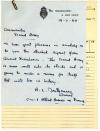
|
AN IMPORTANT HAND-WRITTEN LETTER FROM MONTGOMERY TO DEMPSEY TOGETHER WITH ACCOMPANYING SIGNAL FROM EISENHOWER, Montgomery's letter dated 13/07/44 reads, "I have great pleasure in sending on to you the attached signal from General Eisenhower. The Second Army is now well into its stride and is going to make a name for itself that will live in history. [signed] B.L. Montgomery, General, C-in-C Allied Armies in France", Eisenhower's signal is classed 'Most Immediate' and reads, "From Eisenhower for General Montgomery. Please convey to General Dempsey my great admiration for the accomplishments of the Second Army. In becoming masters of Caen and in their constant drive against the German they are contributing markedly to the final victory. I am proud of them. Signed Eisenhower"
£1,800-2,200
|
|

|
A NUMBER OF ORIGINAL IMAGES OF THE ALLIED HIGH COMMAND IN FRANCE POST D-DAY, most issued by the War Office and with annotations to the reverse by Dempsey, they show various officers in formal groups together with others showing planning operations 'in the field', to include Eisenhower, Montgomery, Dempsey, de Guingand, Ritchie, Broadhurst (RAF), Tedder (RAF), Vian (RN), Crerar, Bradley and Hodges, numbering 16 in total
£250-350
|
|
| |
A FURTHER SET OF IMAGES OF SENIOR ALLIED OFFICERS IN FRANCE, POST D-DAY, four in total and showing two large officer groups with contemporary index of names, one of Dempsey's A.D.C. and admin. staff at his TAC H.Q. and one of allied officers at a planning meeting
£80-120
|
|
| |
A DEDICATED IMAGE OF GENERAL CRERAR GIVEN BY HIM TO DEMPSEY, issued by Canadian Military H.Q. and approx. 9 1/2in. x 7in., a study of General Harry Crerar, C.-in-C. of Canadian troops, with personal dedication to corner (indistinct)
£60-80
|
|
| |
TWO SIGNALS AND A LETTER FROM GENERAL HARRY CRERAR TO DEMPSEY, the letter dated 3rd June 1944 and addressed 'Dear Bimbo' not long before (Crerar's men were under Dempsey's command in France), and the first signal pre-cipher and marked 'SECRET' concerning Canadian armoured break-outs in the Picardie region of France, the second signal sent in acknowledgement of Dempsey's appreciation of the Canadian 4th and 11th Armoured Division's gains
£500-700
|
|
| |
AN ORIGINAL SIGNAL FROM DEMPSEY TO SIR ARTHUR HARRIS, C.-in-C. BOMBER COMMAND, probably sent after the final battle for Caen, it reads, "First day's evacuation of British ex-prisoners by your command most successful. Very many thanks", together with a further signal to A.V.M. Sir Harry Broadhurst send during the Battle for Caen, "Personal for Broadhurst from Dempsey. My most sincere thanks and congratulations to you and all under your command for the magnificent results you are achieving in your air battles and the splendid cover you are giving us"
£70-90
Broadhurst was a keen advocate of aerial support for the army, although his forthright views were not always well-received by his peers. A highly capable pilot himself, Broadhurst championed the use of the Hawker Typhoon and Tempest in a ground attack role, one the aircraft were extremely successful in.
|
|

|
AN ORIGINAL FRAMED IMAGE OF DEMPSEY AND A.V.M. SIR HARRY BROADHURST, taken in Normandy and showing the two men in fairly informal pose, Dempsey is wearing the American pattern flying jacket given to him by Lt.-Gen. William Simpson
£80-120
Provenance: See following Lot for associated provenance.Air Vice Marshal (later A.C.M.) Harry 'Broady' Broadhurst was a colourful character who was looked upon as rather a daredevil pilot in the 1930s. Sometime in the period this photograph was taken, he took Dempsey up to survey the Caen area after the Germans had finally been driven back towards the Falaise Pocket. The aircraft involved was a captured Feiseler Storch (a German army STOL spotter type) which still carried its German markings. Unsurprisingly they were fired upon and had to put-down in a field with Canadian troops advancing upon them, rifles raised. Dempsey reportedly shouted to his friend, "Quick, put your bloody hat on before they shoot the pair of us!".
|
|
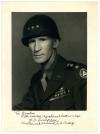
|
THREE LARGE IMAGES OF DEMPSEY WITH LT.-GEN. W.H. SIMPSON, U.S. ARMY, showing Simpson presenting Dempsey with an American flying jacket (see previous Lot) and a letter to Dempsey's Aide-de-Camp enclosing the images, together with a further image with hand-written dedication reading, "To: Bimbo, with sincere regards and best wishes, W.H. Simpson Lieutenant General, U-S Army"
£200-300
|
|
| |
A HAND-WRITTEN LETTER TO DEMPSEY FROM GENERAL COURTNEY HODGES, on First Army headed paper and dated 3rd November [1944], it reads, "My dear Dempsey, Thank you very much for your kind note. We always felt quite secure with you on our left flanks and I shall miss our visits. I know you are going to like Simpson [see previous Lot], your new neighbor [sic]. He is one of the best. My best congratulations on the fine work the Second Army is doing. Best wishes and best of luck. Sincerely, Courtney Hodges [p.s.] We must try to get together on the Rhine soon.", together with an images of the two men together on the banks of the River Rhine
£180-220
|
|
| |
THREE LETTERS FROM GENERAL OMAR BRADLEY, U.S. ARMY TO DEMPSEY, two typed on 12th Army Group headed paper and signed in ink 'Brad', the first dated 3rd December 1944 and reading, "Dear Bimbo, Your five-pound note recalled one bet I had hoped to lose. It would have been more fun paying you. Bill [Simpson] gives me your good regards regularly. Unless we can get together more often, I shall have to deposit mine at the same stop. Best wishes and good luck to you. Sincerely, Brad" the second an exchange of Christmas good cheer from the same year, and the third dated 16th January 1947 where Bradley is writing from Washington illustrating his post-war duties
£300-400
Whilst the two General had a good working relationship during the war, it was to sour somewhat following the publication of Bradley's memoirs in which he was critical of Dempsey's planning in the breakout from Normandy. Dempsey, who did not approve of such autobiographies, wrote to Bradley and aired his displeasure at what he saw as a series of indiscretions.
|
|
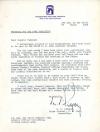
|
TWO HAND-SIGNED LETTERS TO DEMPSEY FROM LT.-GEN. M.B. RIDGEWAY, U.S. ARMY, the first concerning the handing back of Ridgeway's Corp from Dempsey's command to the U.S. 9th Army, a paragraph reads, "For my part, may I say that I have never had happier professional service, nor received greater personal courtesy and consideration than during this period. My relations with Lieutenant General Ritchie, General Officer Commanding XII Corps, have been of the same character, and a source of equally deep and lasting satisfaction to me.", the second letter dated 6th February 1947 and exchanging pleasantries
£150-250
|
|
| |
A SERIES OF HAND-SIGNED LETTERS, MOSTLY CONCERNING THE BATTLE OF THE RHINE, between Dempsey and Lt.-Gen. Smart, Australian Army, Ridgeway, Broadhurst and a later exchange (1947) between Dempsey and Eisenhower, the 25th March 1945 letter to Ridgeway from Dempsey ends, "I am involved with the Prime Minister until about 1400 hrs tomorrow, but I would very much like to see you after that. Will you please have a Jeep with a driver who know [sic] the way to meet me at Bislich bridge at 1415 hrs. I may be anything up to 30 minutes late."
£250-350
|
|
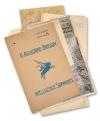
|
A RARE AND HISTORICALLY IMPORTANT DOSSIER '6 AIRBORNE DIVISION INTELLIGENCE SUMMARIES', classified and stamped as 'TOP SECRET' with the front cover displaying the 6th Airborne's crest and numbered 53, this is Dempsey's copy and bears his occasional annotations, containing a multitude of maps (topographical and ordnance-based), intelligence on all aspects of German positions and the make-up of their companies (including names of personnel) and images
£300-400
This is Dempsey's copy of this important summary issued to senior commanders shortly before Operation Plunder began. It appears complete and is a comprehensive study of the information the allies had a their disposal when making planning decisions.
|
|
| |
FOUR WAR OFFICE IMAGES OF DEMPSEY AND EISENHOWER, also included in two of the images are Montgomery, Lt.-Gen. Neil Ritchie (the much-loved commander of XII Corps and others
£80-120
|
|
| |
A DOSSIER OF LETTERS FROM DEMPSEY THANKING HIS SUBORDINATE OFFICERS ON THEIR SUCCESSES, contained within a card dossier with Dempsey's writing in crayon to cover, containing twelve letters thanking his officers, and those passing from his command, for their efforts including this to Brig. Mills-Roberts of 1 Commando following their crossing of the Rhine, "Now that the battle of the Rhine has been won, I am writing to give you and 1 Cde Bde my heartiest congratulations on your great achievement. Your task in the operation was of the greatest importance - the capture of Wesel. The town had to be taken early so that bridges could be built over the river. I gave that task to you because I knew that you would carry it out quickly and cleanly. And so it proved. After a highly skilful crossing of the Rhine, you captured the town against strong opposition with your customary dash and skill. Please tell all ranks of your Brigade how much I admire their splendid performance, and how grateful I am."
£150-200
|
|
| |
A SERIES OF MAINLY WAR OFFICE IMAGES OF THE HIGH COMMAND IN FRANCE, numbering twenty-four in total and showing various posed and natural images of planning operations in France 1944 all with annotations and indexes to the reverse by Dempsey, together with a series of Photo Reconnaissance aerial images of the Rhine and its bridges, taken before and after Operation Plunder
£500-700
|
|
| |
A TRENCH-ART TABLE LIGHTER, the base formed from the head of a 25pdr. shell casing dated 1941 and forming an ash-tray, the whole centrally mounted with a .55 Boys anti-tank rifle-round, the jacket of the bullet removing to reveal a lighter mechanism
£80-120
|
|

|
A SERIES OF IMAGES OF DEMPSEY INSPECTING THE GERMAN NAVAL BASE AT KIEL, taken shortly after the surrender at Luneburg, includes images of Dempsey dining aboard a Wagon-Lits with other officers, taking the salute at the dockside and inspecting captured Kriegsmarine ships (including a light cruiser)
£80-100
Kiel was Germany's main naval base in the Baltic and the majority of her surface ships were built there.
|
|
| |
NINE IMAGES OF DEMPSEY SOON AFTER THE BATTLE OF THE RHINE WAS WON, mostly 10in. x 6 1/2in. and showing Dempsey with Lt.-Gen. Neil Ritchie, the popular O.C. of XII Corps, also a contrived image for the War Office of Dempsey cutting a ribbon to open the first Bailey Bridge over the Rhine near Wesel
£40-60
Dempsey was the first senior British officer to cross the Rhine. This was a conclusive bridgehead with the end of the war in Europe only a matter of weeks away.
|
|

|
THREE HISTORICALLY IMPORTANT BOOKLETS PERTAINING TO THE END OF THE WAR IN NORTH WEST EUROPE, the first being Dempsey's copy of a rare Second Army Thanksgiving Service 'on conclusion of the campaign in north west Europe' with his notes on the frontispiece, the cover with the Second Army shield to the centre surrounded by the emblems of the various corps contained within it, the second a humerous menu card signed by the senior officers present at a meal following the service (including Dempsey Chief of Staff Gen. Peter Pyman), items on the menu include 'Potage Falaise, Poisson a la Seine, Poulet Ardennes, Salade de Ruhr, Glace Victoire and Sauce Luneburg', together with a rare copy of order of service for the Second Army Commemoration Service held at Portsdown
£350-450
The Second Army held a major service for officers and men on 4th June 1944 at Christ Church, Portsdown, shortly before they embarked for Normandy. Following the war a commemoration service was held each year on 6th June to mark the event and remember the many who did not return.
|
|
| |
A LETTER FROM MAJOR GENERAL RIDGEWAY TO DEMPSEY, sent on XVIII headed paper and originating from 'APO 10-0, In the Field' and dated '042355 May 1945', Ridgeway has just met with Maj.-Gen. Smirnov, head of the Red Army's 49th Army and writes to initiate a meeting between the Russians and Dempsey, he closes by stating, "Please accept my whole-hearted admiration and congratulations on the brilliant and now historic achievements of the Second Army", signed in ink
£250-350
|
|
| |
A FRAMED PENCIL SKETCH DRAWN FROM LIFE OF OPERATION VARSITY, approx. 24in. x 11in. including frame and entitled 'Op: Varsity at 1030hrs 24 May 1945, as seen from the bank of the Alter Rhine SE of Xanthen. Fly in of 17 (U.S.) Airborne Division' drawn in detail with C.47 aircraft flying towards the drop-points towing gliders and returning alone over a bombed and smoke-hidden Wesel, bearing a faint dedication to Dempsey (indistinct)
£200-300
|
|
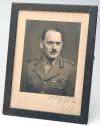
|
A DEDICATED, FRAMED PORTRAIT PHOTOGRAPH OF MAJ.-GEN. SIR FRANCIS de GUINGAND, to Dempsey and approx. 12 1/2in. x 9 1/2in. overall with the dedication "With admiration, and thank-you for all your help and kindness, Freddie des 31/VII/45', single-mounted in a grained leather frame
£200-300
Freddie de Guingand was Montgomery's excellent Chief of Staff who possessed the qualities of patience, diplomacy and resourcefulness (all much-needed to pour oil on the troubled waters his commanding officer often caused).
|
|
| |
DEMPSEY'S MILITARY ADDRESS BOOK, bound in grained leather and containing address details (regiment and club) for many officers of all branches of the services here and abroad
£150-250
|
|
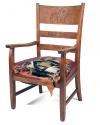
|
AN HISTORICALLY IMPORTANT CHAIR FROM THE MAYORAL CHAMBERS AT LÜNEBURG, of ladder-back design and made from natural oak with unrestored leather-covered horse hair seat (tears to leather), the cresting rail carved in relief showing the town's coat of arms with the mid-rail carved in gothic script 'Stadt Lüneburg', the lower rail, again carved in relief with the date '1939' interspersed with a Mobile, or Sun-Wheel Swastika
£4,000-6,000
Exactly how this chair came to be with Dempsey is not fully known, but the family understands that it was taken from the town's Mayoral Chamber by men of the Second Army and presented to Dempsey shortly before the German surrender at Lüneburg Heath.
|
|
| |
A SERIES OF IMAGES SHOWING DEMPSEY MEETING WITH THE RUSSIAN HIGH COMMAND, 27 images in total all taken 1945, they show Dempsey and senior Russian officers taking the salute from allied soldiers together with more intimate shots, some annotated by Dempsey
£60-80
|
|
| |
A LETTER TO DEMPSEY FROM ALAN MOORHEAD, THE AUSTRALIAN CORRESPONDENT, typed on 21st Army Group headed paper and dated 21st April 1945, the letter invites Dempsey to a dinner with Moorhead and other senior journalists in the field at his camp at Schneverdingen, signed in ink "Yours very sincerely Alan Moorhead"
£50-70
Alan Moorhead O.B.E. was a celebrated war correspondent who was mentioned in dispatches twice and showed a deal of bravery reporting from active theatres. He later wrote a biography of Montgomery which was well-received.
|
|

|
A SERIES OF LARGE OFFICIAL SECOND ARMY VICTORY PARADE PHOTOGRAPHS, numbering 20 original black and white images of Dempsey taking the salute from men of the 2nd Army (several of an armoured division)
£150-200
|
|
| |
POST-WAR LETTERS TO DEMPSEY FROM AUCHINLECK AND O'CONNOR, General Sir Richard O'Connor writes on Eastern Command headed paper dated 6th July 1945, "I must congratulate you on the wonderful finish, and I believe my old Corps had no small part in this", he continues in ink bringing Dempsey news of events in India during the final years of the Raj, together with a later letter to Dempsey, dated 26th February 1946 from Field Marshal Sir Claude Auchinleck on his Commander in Chief of India headed paper in which he writes his thanks for Dempsey's assistance in matters of personnel
£200-300
|
|
| |
ROYAUME DE BELGIQUE
OFFICIAL NOTIFICATION OF A DECORATION BEING AWARDED TO DEMPSEY, on headed paper of the Belgian Minister of Defence, and bearing his seal it reads (translated): The Minister of the National Army has the honour to announce to Lt.-Col. Sir Miles C. Dempsey that according to the decision of the Prince Regent, on the 26th October 1945 he has been declared Great Officer of Leopold Award with Palm, and has received The War Cross 1940 with Palm due to the great services given to Belgium. He is pleased to send him his sincere congratulations for this award."
£350-450
|
|
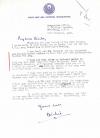
|
A SERIES OF EIGHT EARLY POST-WAR LETTERS FROM LORD LOUIS MOUNTBATTEN TO DEMPSEY, written in the tumultuous period before Indian independence and on headed paper from both S.E.A.C. headquarters (South East Asia Command) and Mountbatten's Broadlands estate, the letters illustrate a growing friendship between the two men and are concerned with various topics such as Dempsey succeeding Viscount Slim in the 14th Army and the wish that Dempsey should then replace Montgomery following his impending retirement as C.I.G.S., in one letter upon hearing of Dempsey's intention to leave the army Mountbatten writes, "I hope you will allow an unbiased person to tell you that your departure would be nothing short of a national disaster, as I honestly consider that you are in a class by yourself, on whom the future of the Army must, to a very large extent, ultimately depend."
£800-1,200
|
|
| |
AN INTERESTING SET OF LETTERS BETWEEN DEMPSEY AND SIR ALAN LASCELLES, the first written from H.M.S. Vanguard (at sea) on Crown paper asks Dempsey for his opinion on whether a revised Army uniform should dispense with the Sam Browne belt and sword, a matter that had occupied The King greatly, this is accompanied by Dempsey's detailed reply and Lascelles acknowledgement of this
£60-80
"Tommy" Lascelles was a much-respected senior courtier whose career culminated in his appointment as Private Secretary to King George VI and then Queen Elizabeth II.
|
|
| |
A SERIES OF OFFICIAL PHOTOGRAPHS OF KING GEORGE VI's VISIT TO THE ROYAL BERKSHIRE REGIMENT, nine images in total showing The King's visit on 7th April 1948 to the Regiment's H.Q. at Brock Barracks, Reading, one image shows King George greeting retired men of the R.B.R. who had served in the Great War and in the Boer War, together with a letter from the War Office that accompanied the images originally, the whole contained within an O.H.M.S. envelope with Dempsey's notes
£60-80
King George VI became the Regiment's Commander-in-Chief at Dempsey's request earlier that year.
|
|

|
OFFICIAL BOUND BOOKLET OF THE QUEEN'S COLOUR PRESENTATION, Dempsey's copy (with his annotation) to mark The Queen's Presentation of Colours to the First Battalion, The Royal Berkshire Regiment at Windsor Castle on 21st July 1956, in a gilt-embossed leatherette cover
£70-90
|
|
| |
A TOP SECRET ADVICE TO THE CHIEFS OF STAFF FROM DEMPSEY CONCERNING THE MIDDLE EAST, dated June 1947 and running to eight pages of Foolscap, in which Dempsey pushes for a far greater sense of direction and protection of our own interests, he closes by saying, "The machine is awaiting the word, but each day that passes makes the execution of the plan more difficult and more costly. Directly the word is given, a load of uncertainty will be removed and we can set about our business in the knowledge that we are working to a goal decided by ourselves in our own interests. And we will find that many of the obstacles in the way of a satisfactory solution in the Middle East will collapse in front of us."
£80-120
|
|
| |
A COMPREHENSIVE COLLECTIONS OF INVITATIONS AND CORRESPONDENCE, pertaining to various events at Buckingham Palace and also the State visit of Queen Wilhelmina of The Netherlands to Great Britain in 1951 and the subsequent presentation to Dempsey of The Order of Orange Nassau, with Swords
£150-250
|
|
| |
"PROBLEMS OF THE DEFENCE OF THE U.K.", NOTES OF DEMPSEY'S LECTURE TO THE I.D.C., dated 31st October 1952 and written during the early years of N.A.T.O., containing Dempsey's thoughts as to the possibility of a third World War (he thought it by no means impossible), and how the U.K. would conduct herself should this arise, together with a page from The Illustrated London News, 19th May 1951 detailed Dempsey's responsibilities in the event of war.
£70-90
|
|

